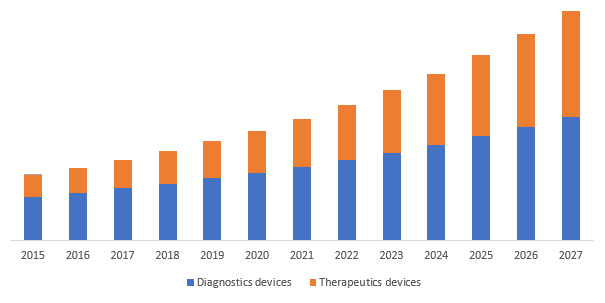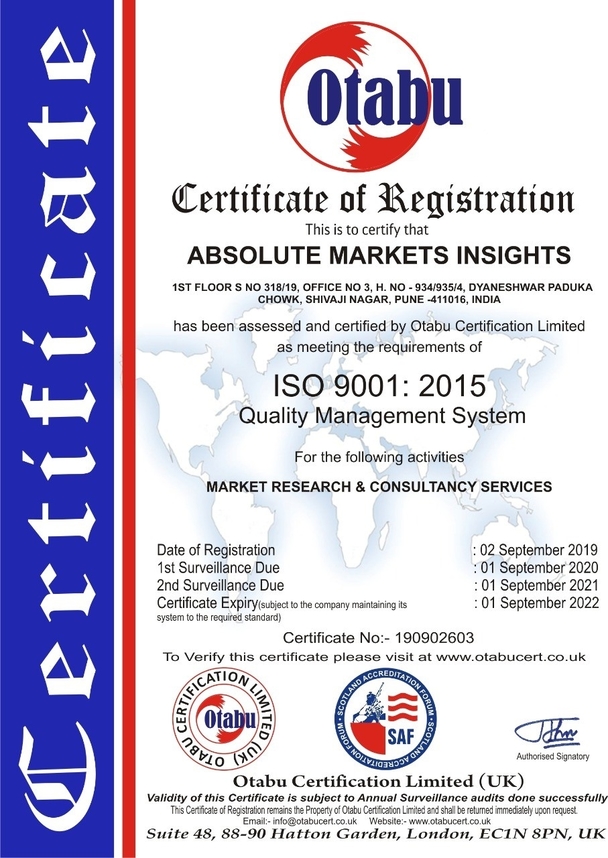
Global sleep apnea devices market is anticipated to grow at a CAGR of 9.7% from 2019 to 2027 and reach US$ 9,510,0 million by 2027, due to rising incidence respiratory disorders, says Absolute Markets Insights
Rising incidence of various respiratory disorders is expected to drive the global sleep apnea devices market growth. The global sleep apnea devices market is estimated to reach a market value of US$ 4,521 million in 2019 and is forecast to reach US$ 9,510 million by 2027, growing at an estimated CAGR of 9.7% over the forecast period.
Increasing incidence of sleep apnea disorders in wide range of age groups is the prominent factor responsible for need, and therefore demand for sleep apnea diagnostics and therapeutics devices. Respiratory disorders caused due to other ailments from the cardiology diseases among the elderly population happens to be a major demand generating parameter in sleep apnea devices market. Adult population, which suffer from breathing problem resulting to snoring is another major consumer base for sleep apnea therapeutic devices.
Increasing occupational disorders also plays a big role in development of various respiratory problems. Acute bronchitis and breathing issues developed due to working in dust and chemical associated industry are rapidly spreading problems across the globe, especially in developing countries. Moreover, spreading smoking habits across the globe has been resulting in increasing rate of respiratory disorders and diseases.
Government initiatives pertaining to sleep apnea awareness and availability of devices addressing the same, are generating new demand and contributing to existing demand. Not only governments, but device manufactures are also taking productive efforts towards raising awareness about sleep related problems and their possible solutions; this in turn proves to be a revenue generating practice for device vendors.
From the supply side of sleep apnea devices market, provision of advanced sleep apnea devices by product manufacturers which offer better reliability is resulting in rapid adoption devices from the sleep apnea product gamut.
In spite of availability of various sleep apnea devices that address different respiratory issues, the adoption of devices is lagging far behind the increasing need. High cost of sleep apnea devices happens to be major reason behind lagging adoption of sleep apnea devices, especially in resource- poor economies.
The detailed research study provides qualitative and quantitative analysis of global sleep apnea devices market. The market has been analyzed from the scope of demand as well as supply. The analysis of demand covers market revenue across regions and further also across all the major countries. The analysis of supply covers the major market players and their regional and global presence and strategies. The geographical analysis emphasizes on each of the major countries across North America, Europe, Asia Pacific, Middle East & Africa and Latin America.
Global Sleep Apnea Devices Market (US$ Million) 2018, By Product

Key Findings of the Report:
- Sleep apnea diagnostics devices market segment held more than 50% of market share in 2018 and is estimated to grow with a steady CAGR over the forecast period. The growth is attributed to rising awareness about early diagnosis of sleep apnea disorders. During the forecast period, the demand for sleep apnea diagnostics devices will largely come from developing countries.
- Sleep apnea therapeutic devices market segment is estimated to grow with CAGR of above 10% over the projection timeframe, owing to increasing technological advancements in therapeutic devices. Increasing early diagnosis rate will largely drive the demand for therapeutic devices around the globe.
- Until recent past, sleep apnea devices have been majorly used in hospitals and sleep laboratories, however, with advents in devices technology, use of devices is rapidly expanding in home care settings. Over the forecast period, home care settings will witness rapid uptake of devices, making sleep apnea home care business the fastest growing market segment.
- Asia Pacific sleep apnea devices market is expected to witness a CAGR of over 11% during the forecast period. Increasing awareness and product adoption will contribute to market growth in this region.
- Key industry participants in global sleep apnea devices market include Fisher & Paykel Healthcare Limited, Invacare Corporation, Phillips Respironics, Compumedics Limited, Cadwell Laboratories, ResMed, BMC Medical Co. Ltd, Braebon Medical Corporation, Nihon Kohden, and ImThera Medical Inc.
- Geographical expansion, introduction of new products, acquisition and collaboration are some of the strategies adopted by companies to expand their reach and gain competitive advantage.
- By Product
- Therapeutic Devices
- Positive Airway Pressure (PAP) device
- Bi-level positive airway pressure (BiPAP) device
- Continuous positive airway pressure (CPAP) device
- Automatic positive airway pressure (APAP) device
- Airway clearance systems
- Adaptive servo-ventilation systems
- Oral appliances
- Oxygen devices
- Masks
- Full face masks
- Nasal masks
- Nasal pillows
- Nasal prongs
- Oral masks
- Tubes
- Humidifiers
- Filters
- Positive Airway Pressure (PAP) device
- Diagnostic Devices
- Actigraphy systems
- Polysomnography (PSG) device
- Respiratory polygraphs
- Pulse oximeters
- Therapeutic Devices
- By Geography
- North America
- U.S.
- Canada
- Mexico
- Rest of North America
- Europe
- France
- The UK
- Spain
- Germany
- Italy
- Nordic Countries
- Benelux Union
- Rest of Europe
- Asia Pacific
- China
- Japan
- India
- New Zealand
- Australia
- South Korea
- Southeast Asia
- Indonesia
- Thailand
- Malaysia
- Singapore
- Rest of Southeast Asia
- Rest of Asia Pacific
- Middle East and Africa
- Saudi Arabia
- UAE
- Egypt
- Kuwait
- South Africa
- Rest of Middle East & Africa
- Latin America
- Argentina
- Brazil
- Rest of Latin America
- North America

